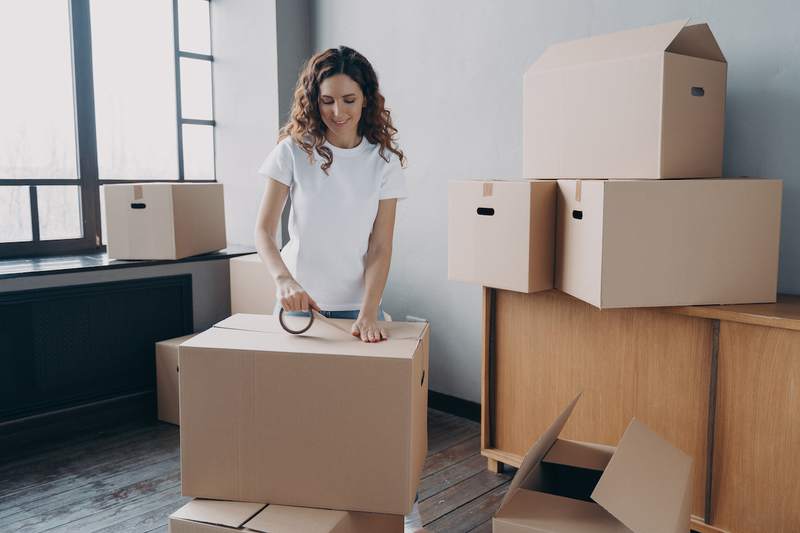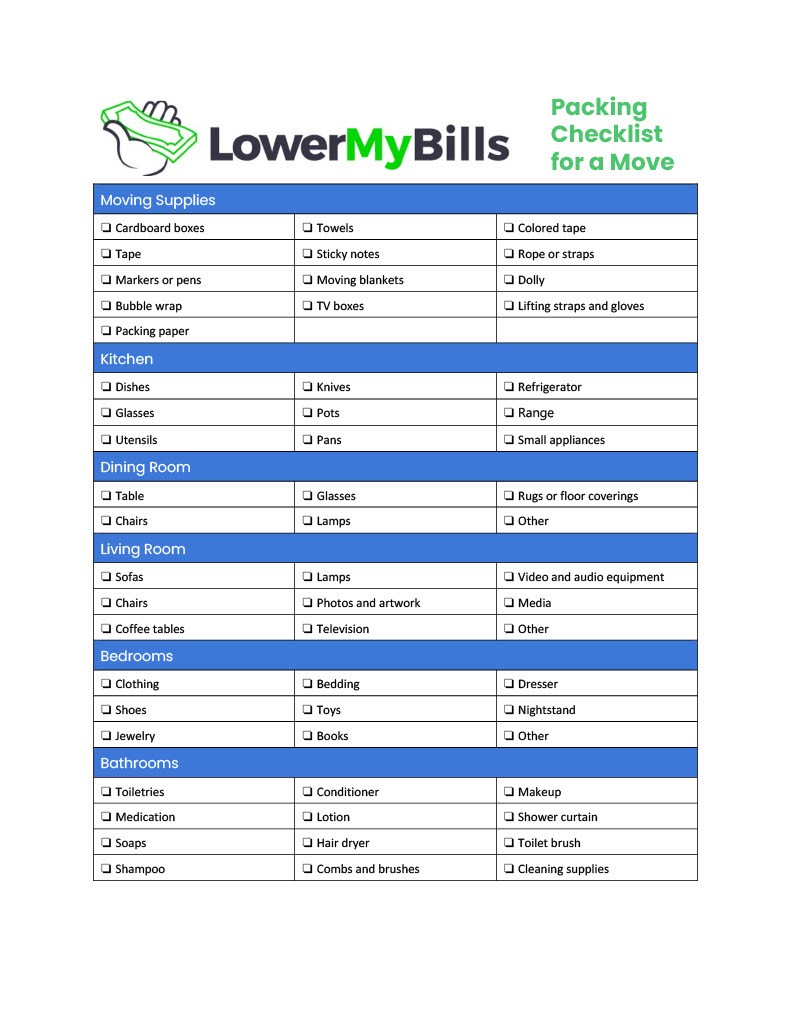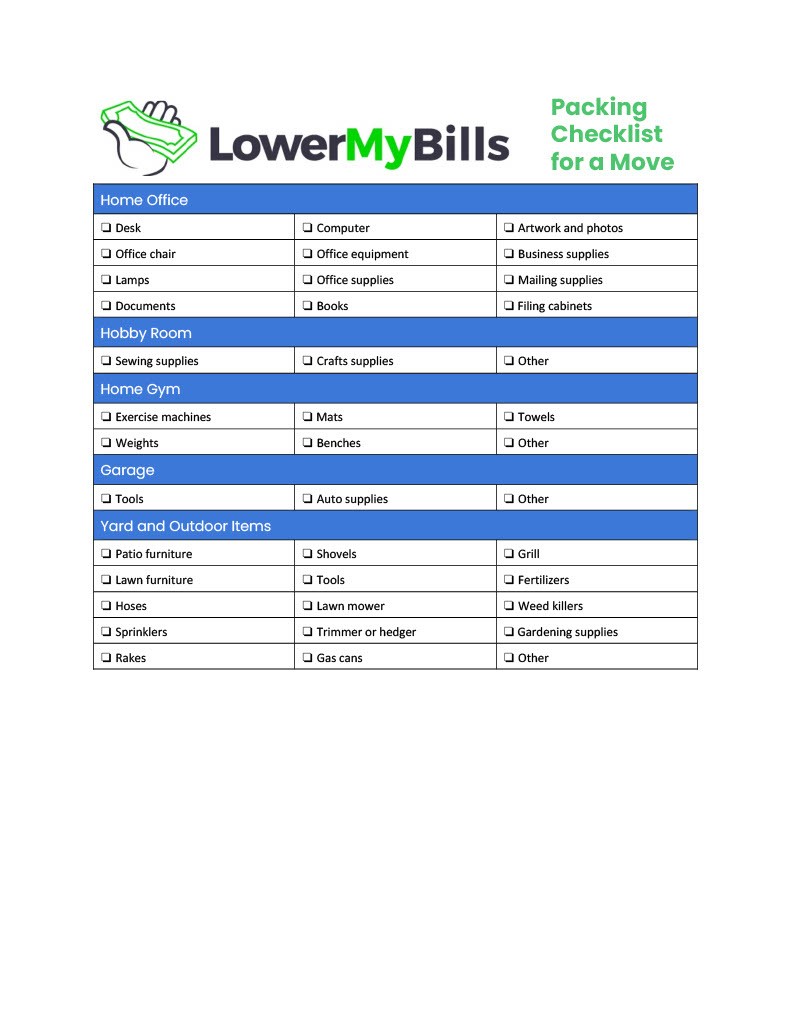Buying a new home is exciting, whether it’s down the road or across the country. Before you can begin your new adventure, you’ll need to pack your belongings and move. While there are companies that can do this for you, many new homeowners box up and transport their stuff themselves.
Here’s how to pack for a move efficiently.
Key Takeaways:
- Most experts suggest first packing the kitchen, followed by rooms with big or bulky furniture, like the dining room or living room.
- Moving companies will transport items that you’ve packed yourself, but might not insure valuables unless they’ve secured and packed them.
- Decluttering, starting early, and keeping checklists can be the keys to moving success.
Preparing To Pack For a Move
Let’s be honest: It’s very stressful to pack everything you own into a truck while still handling everyday life. Having a plan before you begin packing can make the move easier on both you and your wallet.
Preparing to move usually involves some combination of:
- Decluttering your home.
- Determining what needs to be packed.
- Deciding what order to pack your home in.
- Setting a timeline.
- Choosing a hired truck, do-it-yourself trailer, or moving pod.
- Buying supplies.
- Booking movers for heavy furniture or a temporary storage facility, if necessary.
Moving/packing checklists are your friends right now. As soon as you know that a move is on the horizon, it’s helpful to go through each room and identify everything that will and won’t come along with you. Keep a list of things to donate, things to sell, what can be packed ahead of time, and what needs to be packed at the last minute, like clothes and bedding.
You also should begin making a list of large items and heavy pieces that you can’t move by yourself. This will help you determine what kind of help you’ll need on moving day, as well as the size of the truck or pod required for the move.
Essential Packing Supplies
When budgeting for a big move, it can be easy to underestimate the cost of your must-have packing supplies. Boxes, tape, padding, covers — it all adds up. And chances are that you’ll need more of these supplies than you expected once you actually start. Unfortunately, they aren’t an expense you can afford to skip.
“Packing materials are essential for a successful move because they help protect your valuable items,” says Olivia Parks, owner of Professional Organizer New Orleans.
She says many families will need a combination of the following supplies for their move:
- Cardboard boxes in different sizes.
- Tape.
- Markers or pens.
- Bubble wrap.
- Packing paper.
- Towels.
- Sticky notes for color coordination.
Depending on what you own and the best way to pack for moving those items, you also may need:
- Moving blankets that protect your furniture from scratches.
- TV boxes.
- Colored tape.
- Rope or straps.
- A dolly to move boxes and heavy appliances.
- Lifting straps and gloves.
How To Pack
As with any large task, the key to packing up your home is to take it one step at a time.
Choose your strategy
Before you start packing, decide whether you’ll tackle the project yourself or hire professionals. You can hire a team to come in and pack your home for you, to unpack your belongings at your new home, or both. These companies usually provide moving supplies as part of their service, which can save you the hassle of figuring out how many boxes you’ll need and buying them.
But packing services are expensive — anywhere from $300 to $1,000 and up for a two-bedroom home — which makes handling the packing and unpacking yourself the most cost-effective route. In most cases, you’ll want to start this process as early as you can. You might be surprised by how long it can take to pack and how many boxes are actually involved.
Declutter as much as possible
The next big step is deciding what will come along with you to the new home, and what will stay behind.
“Before diving into the packing process, it’s essential to declutter and get rid of any unnecessary items,” Parks says. “Not only will this lighten your load, but it will also make your move more organized and efficient.”
Toss broken items, donate unused clothes and toys, and sell furniture that doesn’t fit your aesthetic anymore. You’ll reduce your moving costs, put extra cash in your pocket, and start your life in your new home without any added clutter.
Start with things you aren’t using
There are many things that you can’t pack until the very end. You’ll need your clothing, appliances, bedding, and even kitchen utensils up until moving day, so packing them too early will just create inconvenience for your family.
What you can do, though, is pack the things that you aren’t actively using.
“Start with the easy stuff like books and off-season clothing,” says Nancy Zafrani, general manager at Oz Moving and Storage in New York City.
This will help you get a jump on the process well ahead of your move-out date, without adding any inconvenience to your daily life.
How To Pack For a Move Room-by-Room
Every room in your home has unique needs when it comes to packing and moving. Here’s a comprehensive packing checklist for moving each room, and some things to note along the way.
Kitchen
Most professionals agree that the most complicated room to pack is the kitchen, so that’s exactly where you should begin your process.
“I would highly recommend starting the packing process in the kitchen,” Parks says. “We’ve packed enough houses to understand that the kitchen often presents the most challenges due to the number of breakable items, various-sized objects, and the mix of heavy and lightweight belongings. Tackling the kitchen first lets you focus on properly cushioning fragile items like dishes, glassware, and small appliances.”
Dining room
Next up on your packing list for moving should be your dining room. That’s because this room typically has a lot of big furniture that can take up space and even require help from professionals. It can also be a relatively simple room to clear, since there isn’t usually a lot of decor or small items to wrap up.
By packing and loading your dining room furniture early on, you can optimize the space in your truck, trailer, or pod.
“Getting the bulky, easy items out of the way clears the space for the more challenging items,” Zafrani says.
Living room
The next area with big furniture should be your living room. Couches, lamps, entertainment centers, televisions, and bookshelves are all large, heavy, and potentially breakable items.
Even if you’re packing and moving most of your home yourself, large items in your living room might require you to get some help. This could mean hiring a crew for a few hours to help with lifting and maneuvering couches, disassembling big furniture, and carefully packing up that big-screen TV. These crews often work hourly and can assist with anything you’re physically unable to move or uncomfortable packing and transporting.
Bedrooms
If you’ve had a chance to declutter, packing bedrooms can be much easier. Just getting rid of clothes you have outgrown or no longer wear can cut down on the number of boxes you’ll need to pack.
For the clothes you’re taking with you, wardrobe boxes can be a great way to transport everything on hangers. These boxes keep your clothes from getting wrinkled and save you time spent unpacking at your new home.
Parks also suggests finding ways to condense what you pack.
“Using vacuum-sealed bags can be a game-changer for compressing bedding, clothes, and other soft items, saving precious space,” she says.
Bathrooms
Your approach to packing up your bathrooms may depend on the distance of your move and your priorities.
Consider using towels, robes, and other soft items to cushion breakable items. If you have a lot of fragile items, like perfume bottles and mirrors, be sure to wrap them with packing paper or bubble wrap to avoid breakage.
Packing toiletries can be a disaster if bottles leak or break. Consider packing some items in a travel bag and bringing them with you in the vehicle, so you don’t risk a box getting crushed or jostled. You may also find that it’s easier to just use up the rest of your soaps, shampoos, conditioners, and lotions, then buy replacements at your new home.
Laundry room
Towels, sheets, extra blankets, and other soft items from your laundry room can be condensed in a vacuum-seal bag.
As with your bathroom items, you might find that buying replacements at your new home is easier than transporting used bottles of liquids and soaps that could leak. You should also note which items you’ll need for your final move-out cleaning, so you don’t pack those things away and have to buy them twice.
Home office
Offices are notorious for heavy and fragile items, so packing up this room may take some time.
Be sure to pack books in small or medium-size reinforced boxes. You might be surprised by just how heavy those little boxes can get. Frames, mirrors, awards, and other fragile items should be wrapped carefully using bubble wrap, packing paper, moving blankets, and corner protectors.
This is another room that might benefit from professional packers, especially if you’re using a moving company to transport your belongings to the new home.
“(Things like) lamps and artwork are tricky,” Zafrani says. “And if you plan to insure it, let the professionals also pack it; most insurers will not cover damaged items that you packed yourself.”
Your home office likely has important documents and personal items that you’ll want to keep with you rather than load into the back of a truck. Financial records, birth certificates, passports, computers, and such should be kept with you during your move, so you don’t risk them getting lost, damaged, or compromised.
Hobby room
If you have a hobby or crafts room, you’ll likely benefit from a bunch of small boxes, organizer bags, and even boxes with dividers. Even a big box of plastic storage bags can be useful here, helping you keep small items organized and contained.
Home gym
Gym equipment can be both heavy and bulky, so professional help — or at least a kind neighbor — might be necessary here, too.
If you have large equipment like a weight rack or treadmill, read your owner’s manual to decide on the best method for disassembly. It’s also important to note that dumbbells and weight plates likely will be too heavy for standard moving boxes, so these may require reinforced boxes or crates to transport.
Garage
If you use your garage mostly for storage, much of what’s in there may already be packed in boxes and bins. Holiday decor, memory boxes, ice chests, sporting equipment — a lot of this can go on the truck as is, without the need for additional boxes.
Other items in your garage, especially heavy belongings, may need special packing or reinforced boxes. Be sure that your boxes and tape are strong enough to support these items, and always stack boxes with heavier things at the bottom.
Yard and outdoor items
Packing up your outdoor items can be overwhelming, since many of these items are too large or awkward for boxes. For example, shovels, trimmers, and seed spreaders can be almost impossible to pack if you don’t have the original boxes, so you might need to use bubble wrap or load them onto the truck as is.
If your belongings will be on a truck or pod for an extended period of time, you probably won’t be able to bring any flammable or hazardous items, like paint thinner or fertilizers. Gas cans will need to be emptied, and you also may need to drain the gas from your lawn mower, snow blower, or other motorized tools.
If you’re moving locally or driving your own stuff, this may not be necessary. However, if another company is loading and moving your belongings, be sure to check with them on what’s prohibited. Even if you’re moving on your own, driving a long distance with flammable or combustible substances can be dangerous.
Tips for Moving Your Stuff
Ideally, our moving/packing list has given you good guidelines for packing and moving your home. Here are some additional tips to keep in mind as you go:
- Keep track of everything. There are a lot of moving parts — pun intended — involved with a move, so keeping a folder with relevant information usually is a great idea. In there, you can organize your packing-to-move checklists, scheduled bookings, contact information, important keys, and more. Be sure to keep this in a safe place so it doesn’t accidentally get packed up.
- Start early. An early start can help prevent a last-minute scramble. “Give yourself enough time to pack,” Zafrani says. “It almost always takes much longer than expected!”
- Book help as early as you can. Shop around and book your movers, packers, and helpers as soon as possible. This will help you lock in the best rates and deals, and take pressure off of your shoulders. It’s especially important if you’re moving during the busy season, which is late spring to early fall.
- Keep valuables with you. Irreplaceable heirlooms, house keys, your work laptop — there are many essentials that you can’t afford to have packed away, especially if there’s a delay with your truck or things get damaged. Be sure to keep these things with you and tucked away in a safe place, like your car, while your former home is being packed up.
- Make sure your truck has a loading ramp. Moving all of your belongings is tough enough without needing to lift each box or piece of furniture onto a truck. If you’re loading your own stuff, be sure to get a truck with a loading ramp so you can just walk right on. Your back will thank you later.
- Get special packing for expensive artwork or other breakables. Valuable art can be tricky to move, and is often irreplaceable. Your mover may offer special crating services and insurance to help ensure that these items make it to your new home safely. While this will be an added expense, the peace of mind can be worth it for your most treasured pieces.
FAQ: How To Pack For a Move
Here are answers to some frequently asked questions about how to pack for a move.
Whether you can leave things in your drawers for a move depends on what’s in there and your mover’s requirements. If your dresser is full of clothes, you probably can leave them in the drawers, as long as you secure the drawers with tape or straps. If you have heavy or breakable items in your drawers, it’s probably better to wrap and pack them separately.
There are many options for packing clothes for a move. Using vacuum-seal bags can save you space, while wardrobe boxes let you transport clothing on hangers. For clothes that you’ll need during the move and the first few days in your new home, you can pack an overnight bag or suitcase.
The kitchen is usually the recommended starting point for a move, as it has a combination of heavy and fragile items that require a lot of time and energy to pack up. Next, focus on rooms with large furniture and bulky items, such as the dining and living rooms. These items will take up a lot of space in your truck or trailer and should be loaded first.
The Bottom Line on Packing For a Move
Buying a house is exciting, but when it comes to packing and moving everything that will go in it, the process can get daunting and tedious. When packing to move, checklists can be a great way to stay on track and optimize your process. You also should declutter as much as you can, and set realistic expectations for yourself and your abilities. Don’t hesitate to hire help with packing or moving heavy and bulky items.








